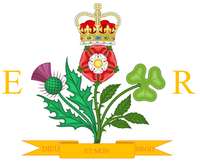Yeomen of the Guard
| The Queen's Bodyguard of the Yeomen of the Guard | |
|---|---|
 Badge of the Yeomen of the Guard | |
| Active | 1485- |
| Country | England |
| Type | Dismounted bodyguard |
| Role | Royal Bodyguard |
| Size | Four Divisions |
| Part of | Sovereign's Bodyguard |
| Garrison/HQ | London |
| Engagements | Boulogne, Boyne, Dettingen |
| Commanders | |
| Colonel in Chief | HM The Queen |
| Captain | The Lord Davies of Oldham |
| Insignia | |
| Collar Badge | Rose, Thistle and Shamrock |


- For the Gilbert and Sullivan operetta, see The Yeomen of the Guard
The Queen's Body Guard of the Yeomen of the Guard are a bodyguard of the British Monarch. The oldest extant British military corps, it was created by Henry VII in 1485 at the Battle of Bosworth Field. As a token of this venerability, the Yeomen still wear red and gold uniforms of Tudor style. There are 60 Yeomen of the Guard (plus 6 Officers), drawn from retired members of the British armed forces. However, the role of the Captain of the Queen's Bodyguard of the Yeomen of the Guard is a political appointment — the Captain is always the government Deputy Chief Whip in the House of Lords.
The Yeomen of the Guard have a purely ceremonial role. They accompany the Sovereign at the annual Royal Maundy Service, investitures and summer Garden Parties at Buckingham Palace, and so on. However, their most famous duty is to 'ceremonially' search the cellars of the Palace of Westminster prior to the State Opening of Parliament, a tradition that dates back to the Gunpowder Plot of 1605, when Guy Fawkes attempted to blow up Parliament. (Today, officers from the Metropolitan Police carry out the search.)
In the eighteenth century some 40 Yeomen were on duty daily, and 20 at night. This only ceased in 1813, and thereafter only one division was required daily until about 1837. Today they are only mustered when required, and receive some three weeks duty notice in advance. They are active on some 30 occasions yearly, so each Yeoman appears for some 6–8 days a year.
All Yeomen are over 42 years of age on appointment, and under 55 years. They must be sergeants or above, but not commissioned. They must also have had at least 22 years' service and have been award the Long Service and Good Conduct Medal (LS&GCM). On reaching the age of 70 years they become supernumerary and no longer are called for service. There are an average of four vacancies a year, which are filled by the Lord Chamberlain, who recommends the names to the Sovereign. The average age of active members is perhaps 60 years. Yeomen are (or were) exempt jury service, received return railway warrants, and an allowance for meals and overnight accommodation where necessary.
The dress worn by the Yeomen of the Guard is in its most striking characteristics the same as it was in the Tudor period. It consists of a royal red tunic with purple facings and stripes and gold lace ornaments, together with a red cross-belt, red knee-breeches and red stockings, flat hat, and black shoes with red, white and blue rosettes are worn. The gold-embroidered emblems on the back and front of the coats consist of the Tudor Crown with the Lancastrian rose, the shamrock and the thistle, the motto "Dieu et mon Droit", and the initials of the reigning sovereign. It is the red cross-belt that distinguishes the Yeomen of the Guard from the Yeomen Warders.
The Senior Messenger Sergeant Major and Wardrobe Keeper lives in a house in St James's Palace, where he is responsible for HQ administration, and correspondence. The Messenger Sergeant Major is his deputy. There are four divisions, First, Second, Third, and Fourth. Each has a Divisional Sergeant Major, Yeoman Bed Goer, Yeoman Bed Hanger, and 13 Yeomen.
The term "Yeomen of the Guard" is frequently misapplied to the Yeomen Warders of the Tower of London, a distinct but similar body. Gilbert and Sullivan's operetta appears to share in this confusion.
Battle Honours
- Field of Stoke, 1487
- Boulogne, 1492
- Blackheath, 1497
- Tournai, 1514
- Boulogne, 1544
- Boyne, 1690
- Dettingen, 1743
- Honours in bold are displayed on the corps' standard.
